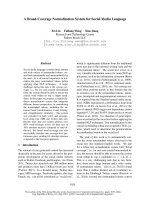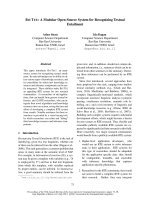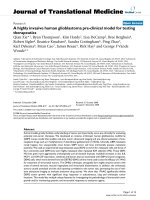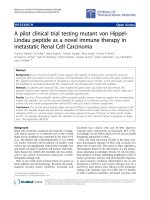Báo cáo hóa học: " A delta-doped quantum well system with additional modulation doping" pot
Bạn đang xem bản rút gọn của tài liệu. Xem và tải ngay bản đầy đủ của tài liệu tại đây (431.89 KB, 5 trang )
NANO EXPRESS Open Access
A delta-doped quantum well system with
additional modulation doping
Dong-Sheng Luo, Li-Hung Lin
2*
, Yi-Chun Su
3
, Yi-Ting Wang
3
, Zai Fong Peng
2
, Shun-Tsung Lo
3
, Kuang Yao Chen
3
,
Yuan-Huei Chang
3
, Jau-Yang Wu
4
, Yiping Lin
1*
, Sheng-Di Lin
4
, Jeng-Chung Chen
1
, Chun-Feng Huang
5
,
Chi-Te Liang
3*
Abstract
A delta-doped quantum well with ad ditional modulation doping may have potential applications. Utilizing such a
hybrid system, it is possible to experimentally realize an extremely high two-dimensional electron gas (2DEG)
density without suffering inter-electronic-subband scattering. In this article, the authors report on transport
measurements on a delta-doped quantum well system with extra modulation doping. We have observed a 0-10
direct insulator-quantum Hall (I-QH) transition where the numbers 0 and 10 correspond to the insulator and
Landau level filling factor ν = 10 QH state, respectively. In situ titled-magnetic field measureme nts reveal that the
observed direct I-QH transition depends on the magnetic component perpendicular to the quantum well, and the
electron system within this structure is 2D in nature. Furthermore, transport measurements on the 2DEG of this
study show that carrier density, resistance and mobility are approximately temperature (T)-independent over a wide
range of T. Such results could be an advantage for applications in T-insensitive devices.
Introduction
Advances in growth technology have made it possible to
introduce dopants which are confined in a single at omic
layer [1]. Such a technique, termed delta-doping, can be
used to prepare structures which are of great potential
applications. For example, many novel structures based
on delta-doped structures [2-10] can be experimentally
realized using very simple fabrication techniques. It is
found that delta-doped quantum wells may suffer from
surface depletion and carrier freeze-out, which compro-
mise their performances, thereby limiting their potential
applications. T o this end, a delt a-doped quantum well
with additional modulation doping can be useful. The
modulation doping provides extra electrons so as to
avoid carrier freeze-out. On the other hand, it preserves
the adv antages of a delta-doped quantum well structure,
such as an appreciable radiative recombination rate
between the two-dimensional electron gas (2DEG) and
the photo-generated holes [9], and an extremely high
2DEG density, suitable for high- power field effect
transistor [8]. It is worth mentio ning that doped quan-
tum wells with additional modulation doping [11-16]
have already been used to study the insulator-quantum
Hall (I-QH) transition [17-23], a very fundamental issue
in the fields of phase transition and L andau quantiza-
tion. In order to fully realize its potential as a building
block of future devices, it is highly desirable to obtain
thorough understanding of the basic properties of a
delta-doped quantum well with additional modulation
doping. In this article, extensive resistance measure-
ments on such a structure are described. At low tem-
peratures (0.3 K ≤ T ≤ 4.2 K), the authors have observed
a low-field direct I-QH transition. In situ tilted-field
experiments demonstrate that the observed direct I-QH
transition only depends on the magnetic field compo-
nent applied perpendicular to the quantum well, and
thus the electron system within our device is 2D in nat-
ure. Resistivity, carrier density, and hence mobility of
the device developed are all weakly temperature depen-
dent. T hese results may be useful for simplifying circui-
try design for low-temperature amplifiers, and devices
for space technology and satell ite communications since
extensive, costly and time-consuming tests both at room
* Correspondence: ; ;
1
Department of Physics, National Tsinghwa University, Hsinchu, 300, Taiwan.
2
Department of Electrophysics, National Chiayi University, Chiayi, 600, Taiwan.
Full list of author information is available at the end of the article
Luo et al. Nanoscale Research Letters 2011, 6:139
/>© 2011 Luo et al; licensee Springer. This is an Open Access article distri buted unde r the terms of the Creative Commons Attribution
License ( which permits unrestricted u se, distribution, and reproduction in any medium,
provided the original work is properly cited.
temperature and at low temperatures may not be
required.
Experimental details
Thesamplethatweusedintheseexperimentswas
grown by molecular beam epitaxy (MBE). The layer
sequence was grown on a semi-insulating (SI) GaAs
(100) substrate as follows: 500 nm GaAs, 80 nm
Al
0.33
Ga
0.67
As, 5 nm GaAs, Si delta -doping with a den-
sity of 5 × 10
11
cm
-2
,15nmGaAs,20nmundoped
Al
0.33
Ga
0.67
As, 40 nm Al
0.33
Ga
0.67
As layer with a Si-dop-
ing density of 10
18
cm
-3
, and 10 nm GaAs cap layer. It
is found that electrical contacts to a delta-doped q uan-
tum well with the same doping concentration do not
show Ohmic behaviour at T <30K.Therefore,addi-
tional modu lation doping is introduced in order t o pro-
vide extra carriers so as to avoid this unwanted effect.
As shown later, the carrier density of the 2DEG is
indeed higher than the del ta-doping concentration.
Moreover, the electrical contacts to the 2DEG all show
Ohmic behaviour over the whole temperature range (0.3
K ≤ T ≤ 290 K). Both results demonstrate the usefulness
of additional modulation doping. T he sample was pro-
cessed into a Hall bar geometry using standard optical
lithography. The sample studied in this study is different
from that reported in Ref. [14] but was cut from the
same wafer. Low-temperature magnetotranspo rt mea-
surements were performed in a He
3
cryostat equipped
with an in situ rotating insert. Transport measurements
over a wide range of temperature were performed in a
closed-cycle syste m e quipped with a water-cooled elec-
tric magnet.
Results
In the system developed in this study, ionized Si dopants
confined in a layer of nanoscale can serve as nano-
scatterers close to the 2DEG. Figure 1a shows longi-
tudinal and Hall resistivity measurements at various
temperatures when the magnetic field is applied perpen-
dicular to the plane of the 2DEG. Minima in r
xx
corre-
sponding to Landau level filling factors ν =8,6and4
are observed. On the other hand, r
xy
is linear at around
ν = 8 and 6, and shows only a step-like structure, not a
quantized Hall plateau at around ν = 4. We can see that
at the crossing field B
c
, appro ximately 2.4 T, where the
corresponding filling factor is about 10, r
xx
is appro xi-
mately T-independent. Near the crossing field, r
xx
is
close to r
xy
. Therefore, w e o bserve a low-field direct
I-QH transition, consistent with existing theory and
experimental results [13-16,18-22]. In order to further
study this effect, the sample was tilted in sit u so that
Figure 1 Four-terminal magnetoresistance measurements:(a)
Longitudinal resistivity r
xx
measurements as a function of magnetic
field r
xx
(B) at various temperatures. Hall resistivity r
xy
as a function
of B at T = 1.9 K is shown. (b) Longitudinal resistivity measurements
as a function of total magnetic field r
xx
(B
tot
) at various
temperatures. (c) Longitudinal resistivity measurements as a
function of the perpendicular component of the applied magnetic
fieldr
xx
(B
perp
) at various temperatures.
Luo et al. Nanoscale Research Letters 2011, 6:139
/>Page 2 of 5
the angle between the applied B and growth direction is
28.5°. Figure 1b shows r
xx
and r
xy
as a function of total
magnetic field which is applied perpendicular to the
2DEG plane at various temp eratures. The ν = 4 QH-like
state is now shifted to a higher field of B approximately,
7 T. Similarly, the crossing field is shifted to a higher
field of approximately, 2.9 T. The authors now re-plot
the data as a function of perpendicular component of
the total magnetic field, as shown in Figure 1c. It can be
seen that both crossing field and the minimum in r
xx
corresponding to the ν = 4 QH-like state are now the
same as those shown in Figure 1a. The results therefore
demonstrate that the electron system are indeed 2D in
nature since all the fe atures only depend on the B com-
ponent perpendicular to the growth direction. Further-
more, the corresponding approximately T-independent
point in r
xx
at the crossing field is the same, despite an
in-plane magnetic field of approximately 1.4 T being
introduced in our tilted-field measurements.
As mentioned earlier, it is highly desirable to obtain
a thorough understanding of the basic properties of
our system so as to fully realize its potential in electro-
nic and optoelectronic devices. Figure 2a shows resis-
tivity measurements as a function of T over a wide
range of temperature. Interestingly, r
xx
is almost T-
independent from room temperature down to 23 K.
To understand why r
xx
at B = 0 is insensitive to the
temperature, the T-dependence of n is investigated,
and μ is obtained using r
xx
=1/neμ at zero magnetic
field, as shown in Figure 2b, c. The carrier concentra-
tion does not decrease too much, and thus the 2DEG
does not suffer from the carrier freeze-out at low tem-
peratures because of the extra modulation doping.
While μ increases with decreasing T in most 2DEG
because of the reduced electron-phonon scattering, it
can bee seen from Figure 2c that μ saturates and
remains a t approximately 0.37 m
2
/v/s from T = 230 K.
For a 2DEG in the delta-doped quantum well, with
decreasing T, it shall be considered that the enhance-
ment of the multiple scattering may decrease the
mobility and thus compensate the reduced electron-
phonon scattering effect [6,7]. Therefore, we can
design the devices insensitive to T by using the delta-
doped quantum well with the extra modulation doping.
For example, when designing a circuit for a low-
temperature amplifier, such as the one used for spa ce
technology and satellite communications, one needs to
perform a test at room temperature (RT) first. When
cooling down the amplifier, its characteristics can be
significantly different since the resistance of the device
based on HEMT structure may be a lot lower than
that at RT [24]. Therefore substantial variation in
the circuitry design based on the RT test is required.
Since the r
xx
, n and μ of our structure are almost
T-independent over a wide range of temperature, a RT
test may be sufficient.
Both the strong and weak localization effects can com-
pensate the reduced electron-phonon effect with
decreasing T. To clarify the dominant mechanism lead-
ing to the compensation in this study, it is noted that
the direct I-QH transition inconsistent with the global
Figure 2 Electrical measurements over a wide range of
temperature:(a) Resistivity as a function of temperature r
xx
(T), (b)
carrier density as a function of temperature n(T), and (c) mobility as
a function of temperature μ(T).
Luo et al. Nanoscale Research Letters 2011, 6:139
/>Page 3 of 5
phase diagram of the qua ntum Hall effect reveals the
absence of the strong localization [17,18]. The magneto-
oscillations following the semiclassical Shubnilkov-de
Haas formula when B < 6T also indicates that the
strong localization is not significant near B = 0 [14,23].
Therefore, the weak localization effect should be respon-
sible for the enhancement of the multiple scattering,
compensating for the reduced electron-phonon effect
[25].
Conclusions
In summa ry, electrical measu rements of a delta-doped
single quantum well with additional modulation doping
have been presented. A direct I-QH transition in such a
structure has been observed. In situ tilted-field measure-
ments demonstrate that the observed 0-10 transition
only depends on the magnetic field component applied
perpendicular to the quantum well, and therefore the
electron system within the sample studied is 2D in nat-
ure. Neither carrier freezeout nor second electronic sub-
band at a high density of 6.5 × 10
15
m
-2
is observed in
the system proposed. Transport measurements over a
wide range of temperature reveal that r
xx
, n and μ all
show very weak T dependencies. These results could be
useful for devices which can maintain their characteris-
tics over a wide range of temperature. Our results could
also be useful for circuit design for low-temperature
amplification, and devices for space technology and
satellite communications.
Abbreviations
2DEG: two-dimensional electron gas; I-QH: insulator-quantum Hall; MBE:
molecular beam epitaxy; RT: room temperature; SI: semi-insulating; T:
temperature.
Acknowledgements
This study was funded by the NSC, Taiwan.
Author details
1
Department of Physics, National Tsinghwa University, Hsinchu, 300, Taiwan.
2
Department of Electrophysics, National Chiayi University, Chiayi, 600, Taiwan.
3
Department of Physics, National Taiwan University, Taipei, 106, Taiwan.
4
Department of Electronics Engineering, National Chiao Tung University,
Hsinchu, 300, Taiwan.
5
National Measurement Laboratory, Centre for
Measurement Standards, Industrial Technology Research Institute, Hsinchu,
300, Taiwan.
Authors’ contributions
DSL, LHL, YTW and ZFP performed the low-temperature tilted-field
measurements. YCS, STL, and KYC performed the measurements over a wide
range of temperature. YHC started the project. CFH and CTL drafted the
manuscript. YL and JCC coordinated the measurements. JYW processed the
sample. SDL grew the MBE wafer. All authors read and approved the final
manuscript.
Competing interests
The authors declare that they have no competing interests.
Received: 31 July 2010 Accepted: 14 February 2011
Published: 14 February 2011
References
1. Wood GEC, Metze G, Berry J, Eastman LF: Complex free-carrier profile
synthesis by “atomic-plane’’ doping of MBE GaAs. J Appl Phys 1980,
51:383.
2. Liu DG, Lee CP, Chang KH, Wu JS, Liou DC: Delta-doped quantum well
structures grown by molecular beam epitaxy. Appl Phys Lett 1990,
57:1887.
3. Wagner J, Ramsteiner M, Richards D, Fasol G, Ploog K: Effect of spatial
localization of dopant atoms on the spacing of electron subbands in δ-
doped GaAs:Si. Appl Phys Lett 1991, 58:143.
4. Kim Y, Kim MS, Min SK: Properties of center and edge δ-doped GaAs-
AlGaAs quantum wells grown by metalorganic chemical vapor
deposition. Appl Phys Lett 1993, 62:741.
5. Kim TW, Kim Y, Min SK: Magnetotransport and electric subband studies
of Si-delta-doped Al
0.27
Ga
0.73
As/GaAs single quantum wells grown by
metalorganic chemical vapour deposition. Thin Solid Films 1995, 254:61.
6. Lee CH, Chang YH, Suen YW, Lin HH: Magnetic-field-induced insulator-
quantum Hall conductor-insulator transitions in doped GaAs/AlxGa1-xAs
quantum wells. Phys Rev B 1997, 56:15238.
7. Lee CH, Chang YH, Suen YW, Lin HH: Magnetic-field-induced
delocalization in center-doped GaAs/Al
x
Ga
1-x
As multiple quantum wells.
Phys Rev B 1998, 58:10629.
8. Lee CH, Chang YH, Huang CF, Huang MY, Lin HH, Lee CP: Transport and
Optical Studies of the D–Conduction Band in Doped GaAs/AlGaAs
Quantum Wells. Chin J Phys 2001, 39:363.
9. Wagner J, Fischer A, Ploog K: Fermi edge singularity and screening
effects in the absorption and luminescence spectrum of Si δ-doped
GaAs. Appl Phys Lett 1991, 59:428.
10. Oubram O, Mora-Ramos ME, Gaggero-Sager LM: Effect of the hydrostatic
pressure on two-dimensional transport in delta-doped systems. Eur J
Phys 2009, 71:233.
11. Kim GH, Liang CT, Huang CF, Nicholls JT, Ritchie DA, Kim PS, Oh CH,
Juang JR, Chang YH: From localization to Landau quantization in a two-
dimensional GaAs electron system containing self-assembled InAs
quantum dots. Phys Rev B 2004, 69:073311.
12. Chang WH, Lin CH, Fu YJ, Lin TC, Lin H, Cheng SJ, Lin SD, Lee CP: Impacts
of Coulomb Interactions on the Magnetic Responses of Excitonic
Complexes in Single Semiconductor Nanostructures. Nanoscale Res Lett
5:680.
13. Huang TY, Juang JR, Huang CF, Kim GH, Huang CP, Liang CT, Chang YH,
Chen YF, Lee Y, Ritchie DA: On the low-field insulator-quantum Hall
conductor transitions. Physica E 2004, 22:240.
14. Chen KY, Chang YH, Liang CT, Aoki N, Ochiai Y, Huang CF, Lin LH,
Cheng KA, Cheng HH, Lin HH, Wu JY, Lin SD: Probing Landau quantization
with the presence of insulator-quantum Hall transition in a GaAs two-
dimensional electron system. J Phys: Condens Matter 2008, 20:295223.
15. Huang TY, Liang CT, Kim GH, Huang CF, Huang CP, Lin JY, Goan HS,
Ritchie DA: From insulator to quantum Hall liquid at low magnetic fields.
Phys Rev B 2008, 78:113305.
16. Huang TY, Huang CF, Kim GH, Huang CP, Liang CT, Ritchie DA: An
Experimental Study on the Hall Insulators. Chin J Phys 2009, 47:401.
17. Kivelson S, Lee DH, Zhang SC: Global phase diagram in the quantum Hall
effect. Phys Rev B 1992, 46:2223.
18. Huckestein B: Quantum Hall Effect at Low Magnetic Fields. Phys Rev Lett
2000, 84:3141, and references therein.
19. Huang CF, Chang YH, Lee CH, Chou HT, Yeh HD, Liang CT, Chen YF,
Lin HH, Cheng HH, Hwang GJ: Insulator-quantum Hall conductor
transitions at low magnetic field. Phys Rev B 2002, 65:045303.
20. Song SH, Shahar D, Tsui DC, Xie YH, Monroe D: New Universality at the
Magnetic Field Driven Insulator to Integer Quantum Hall Effect
Transitions. Phys
Rev Lett 1997, 78:2200.
21. LinJY,ChenJH,KimGH,ParkH,YounDH,JeonCM,BaikJM,LeeJL,
Liang CT, Chen YF: Magnetotransport Measurements on an AlGaN/
GaN Two-Dimensional Electron System. J Korean Phys Soc 2006,
49:1130.
22. Chen KY, Liang CT, Aoki N, Ochiai Y, Cheng KA, Lin LH, Huang CF, Li YR,
Tseng YS, Yang CK, Lin PT, Wu JY, Lin SD: Probing Insulator-quantum Hall
Transitions by Current Heating. J Korean Phys Soc 2009, 55:64.
23. Lo ST, Chen KY, Lin TL, Lin LH, Luo DS, Ochiai Y, Aoki N, Wang YT, Peng ZF,
Lin Y, Chen JC, Lin SD, Huang CF, Liang CT: Probing the onset of strong
localization and electron-electron interactions with the presence of a
Luo et al. Nanoscale Research Letters 2011, 6:139
/>Page 4 of 5
direct insulator-quantum Hall transition. Solid State Commun 2010,
150:1902.
24. Boutez C, Crozat P, Danelon V, Chaubet M, Febvre P, Beaudin G: A low-
noise cryogenically-cooled 8-12 GHz HEMT Amplifier for future space
applications. Int J Infrared Millimeter Waves 1997, 18:85.
25. Pfeiffer L, West KW, Stormer HL, Baldwin KW: Electron mobilities exceeding
107 cm2/Vs in modulation-doped GaAs. Appl Phys Lett 1989, 55:1888.
doi:10.1186/1556-276X-6-139
Cite this article as: Luo et al.: A delta-doped quantum well system with
additional modulation doping. Nanoscale Research Letters 2011 6:139.
Submit your manuscript to a
journal and benefi t from:
7 Convenient online submission
7 Rigorous peer review
7 Immediate publication on acceptance
7 Open access: articles freely available online
7 High visibility within the fi eld
7 Retaining the copyright to your article
Submit your next manuscript at 7 springeropen.com
Luo et al. Nanoscale Research Letters 2011, 6:139
/>Page 5 of 5









